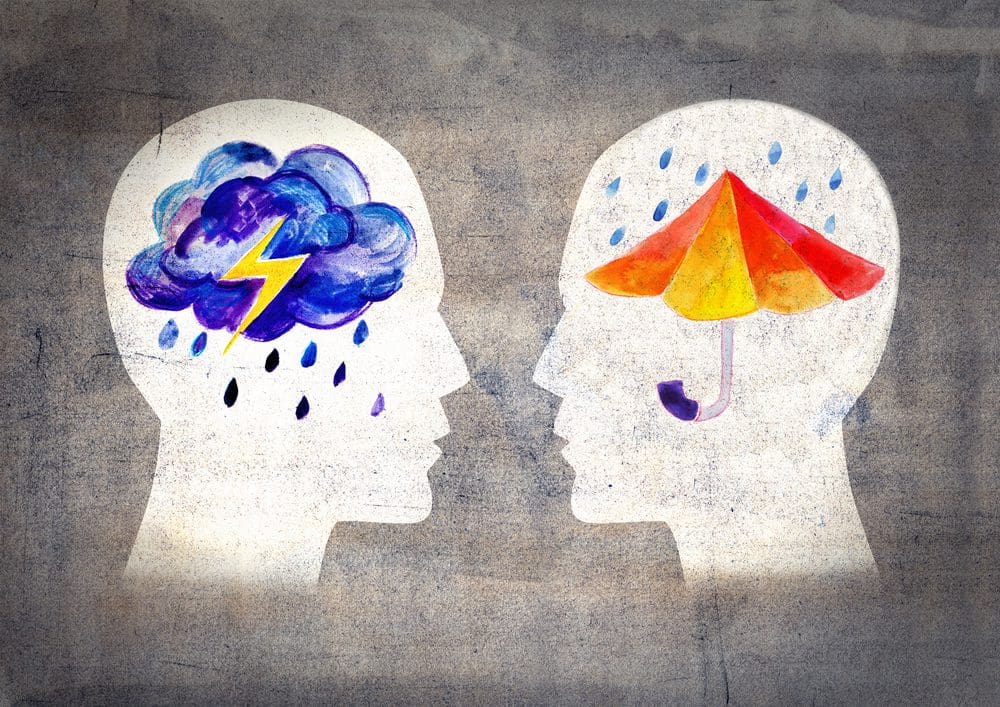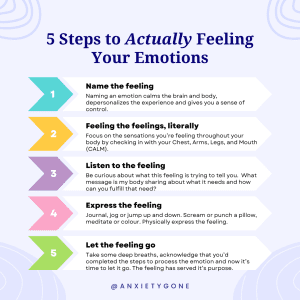Full Disclosure: Clicking on these links could mean a tiny commission for me, at no extra cost to you.
Let’s be honest here: feelings are scary. If they weren’t, we wouldn’t all be out here juggling our mental health and trying to figure out what to do with these stored thoughts, emotions and memories. The reality is, many of us don’t only just ignore our feelings; we actively go out of our way to avoid even acknowledging that they exist. And as the saying goes, what we don’t process, the body stores. So, it’s time to let yourself feel feelings, so you can finally be free from them.
What Are Emotions?
Emotions. We all have them. It’s our body’s way of communicating with us. They’re not just feelings either. Emotions are complex states that blend together what we experience, how our body reacts and how we express ourselves. Think of them as your internal communication system, giving you valuable insights about what’s happening inside you and in the world around you.
There’s no denying that many emotions feel great, like happiness and joy. Unfortunately, there are just as many that can be downright unbearable, hence why we try to ignore them.
While it’s true that feeling emotions like anxiety, grief, or anger isn’t exactly fun, ignoring them isn’t a good idea. Suppressing these feelings only leads to stress or causes them to erupt and disrupt your life in inappropriate ways. More importantly, every emotion has a message and it’s our job to get to the bottom of them. Yes, even the tough ones.
The Importance of Feeling and Feelings
Emotions are far more than fleeting feelings that pass through our minds. Feeling and feelings are vital to our overall well-being and play an essential role in various aspects of our lives. In other words, we have to feel feelings, no matter how difficult and uncomfortable the may be. It’s just part of the process.
Here are several reasons why feeling and feelings are incredibly important:
Decision-Making
Emotions significantly influence our decision-making processes. They help us weigh the pros and cons of different choices and guide us toward actions that align with our values and needs. For example, feelings of joy and excitement can motivate us to pursue new opportunities, while fear can alert us to potential dangers and prompt caution.
Building and Maintaining Relationships
Emotions are the foundation of our relationships. They help us connect with others on a deeper level, building empathy, understanding, and compassion. Positive emotions like love, happiness, and gratitude strengthen our bonds with friends, family, and partners. Even challenging emotions like anger or sadness, when expressed healthily, can lead to growth and stronger connections.
Self-Awareness and Personal Growth
By paying attention to our emotions, we gain valuable insights into our inner world. This self-awareness is crucial for personal growth and development. Understanding our emotional triggers and patterns allows us to manage our responses better, improve our emotional intelligence, and foster resilience.
Motivation and Goal Achievement
Emotions serve as powerful motivators. They drive us to set and achieve goals, overcome obstacles, and pursue our passions. Positive emotions like excitement and anticipation can energize us, while even negative emotions like frustration can fuel determination and perseverance.
Physical and Mental Health
Emotions have a profound impact on our physical and mental health. Positive emotions can boost our immune system, reduce stress, and promote overall well-being. Conversely, chronic suppression of negative emotions can lead to various health issues, including anxiety, depression, and physical ailments like heart disease and digestive problems. Acknowledging and processing our emotions is essential for maintaining a healthy mind and body.
Communication and Expression
Emotions are a fundamental part of how we communicate with others. They add depth and authenticity to our interactions, allowing us to express ourselves fully and understand others better. Emotional expression through words, facial expressions, and body language helps us convey our feelings and intentions clearly, enhancing interpersonal communication.
Learning and Adaptation
Emotions are crucial for learning and adaptation. They help us remember experiences, both positive and negative, and adjust our behavior accordingly. Fear, for example, teaches us to avoid harmful situations, while happiness reinforces behaviors that lead to rewarding outcomes. This emotional feedback loop is essential for our survival and growth.
Providing Meaning and Purpose
Emotions add richness and depth to our lives, giving us a sense of meaning and purpose. They shape our experiences and memories, making life more vibrant and fulfilling. By embracing our emotions, we can live more authentically and align our actions with our true selves.
Breathe Into Healing
Inward Breathwork offers guided breathwork sessions designed to reduce stress and enhance your well-being.
Try it now with a 14-day free trial and feel the difference breathwork can make. Click here to start your journey to a calmer, more focused you today!
Don’t wait – your path to peace begins with a single breath.
The Impact of Suppressed Emotions
Suppressing emotions can have profound and far-reaching effects on both physical and mental health. When we avoid feeling our feelings, we aren’t eliminating them. Instead, we are just pushing them further down until eventually, they will burst out of our body in unhealthy, often times, detrimental ways. Understanding these impacts can help us understand the importance of feeling our emotions and finding healthy ways to process them.
Chronic Stress and Anxiety:
Suppressed emotions often contribute to chronic stress. When emotions like anger, sadness, or fear are not expressed, they can build up, causing the body to remain in a constant state of stress. This can lead to increased levels of cortisol, a stress hormone, which negatively affects various bodily systems 1.
Chronic stress can result in health issues such as headaches, muscle tension, and gastrointestinal problems. Long-term exposure to high cortisol levels can also weaken the immune system, making the body more susceptible to illnesses .
Cardiovascular Problems:
Holding in emotions, especially anger and frustration, can increase the risk of cardiovascular issues. Studies have shown that repressed anger is associated with higher blood pressure and an increased risk of heart disease 2.
Sleep Disorders:
Unprocessed emotions can lead to sleep disturbances, such as insomnia or restless sleep 3. The mind’s inability to shut down due to unresolved emotional issues can prevent restful sleep, leading to fatigue and further health complications .
Depression and Anxiety:
Suppressed emotions are a significant contributing factor to mental health disorders like depression and anxiety. When emotions are not acknowledged and processed, they can lead to feelings of hopelessness and persistent sadness 4. Anxiety can arise from the constant effort to keep emotions at bay, creating a cycle of worry and fear .
Emotional Outbursts and Unpredictable Behavior:
Bottling up emotions can cause them to erupt unexpectedly. This can lead to inappropriate emotional outbursts that can harm relationships and social interactions. The inconsistency between one’s external behavior and internal feelings can create significant psychological distress .
Decreased Emotional Resilience:
Regularly suppressing emotions can decrease emotional resilience. This means that individuals may find it harder to cope with future emotional challenges, as they have not developed the skills to effectively manage and process their emotions .
Substance Abuse and Addictive Behaviors:
People often turn to substances like alcohol, drugs, or even food as a way to numb or escape from unprocessed emotions 5. This can lead to substance abuse and addiction, creating further physical and mental health problems .
Social Isolation:
Suppressing emotions can lead to social withdrawal and isolation. Individuals may feel misunderstood or believe that they cannot express their true feelings, which can hinder their ability to form and maintain meaningful relationships .
Common Signs of Suppressed Emotions
Recognizing these signs is the first step towards addressing and feeling your emotions. Here are some common signs of unprocessed emotions:
- Irritability and Mood Swings
- Fatigue and Low Energy
- Difficulty Concentrating
- Physical Ailments (e.g., headaches, stomachaches)
- Emotional Numbness
- Avoidance Behaviors (e.g., binge-watching, overworking)
- Social Withdrawal
- Procrastination
- Substance Use
- Overreacting to Minor Issues
- Feeling Overwhelmed
- Restlessness and Anxiety
How to Feel Feelings in 5 Easy Steps
In a world that often tells us to “keep calm and carry on,” many of us have become experts at bottling up our emotions. Yet, the path to true healing and emotional well-being lies in allowing ourselves to fully experience and understand our feelings. Learning how to feel feelings might sound straightforward, but it’s a skill that many of us need to develop. Here are some practical steps and techniques to help you learn how to feel your emotions, so you can create a foundation for genuine healing and personal growth.
1. Name the Feeling
When a feeling arises, the first step is to label it. Research indicates that simply naming an emotion can calm the brain and body, while also helping to depersonalize the experience, and give you a sense of control.
Next time you feel an emotion, take a few deep breaths and honestly name what you’re experiencing. Anger. Sadness. Embarrassment. Shame. Name that beast.
Repeating a few words out loud can further help create some distance from your emotions.
Instead of saying “I am anxious” try:
- “I feel anxious”
- “This is anxiety”
- “Anxiety is present”
These phrases remind you that while you are experiencing an emotion, you are not defined by it. The emotion is just that – a feeling – and you, my friend, are so much more than that.
2. Feel Your Feelings, Literally
Once you’ve labeled the feeling, set aside any thoughts about why you’re feeling this way or your thoughts about the feeling itself. Instead, focus on the physical sensations associated with it.
Try the CALM method by checking in with your Chest, Arms, Legs, and Mouth. In each of these areas (or any others that draw your attention), ask yourself if it feels:
- Tight or loose?
- Hot or cold?
- Tired or energized?
- Tingling or numb?
- Anything else?
Simply observe what’s present.
3. Listen to The Feeling
After sitting with the sensations of the emotion, become curious about what this feeling is trying to tell you. Imagine you could “listen” to the emotion as you would a friend. Ask yourself:
- What message is my body sharing about what it needs?
- What truth might this feeling be highlighting?
- What action is called for?
- What connection does it need?
Spend some time considering how you might support the need or actions that come up. The need might be physical (rest, a hug, a change) or emotional (care, validation, love).
Don’t overthink it. If there’s no clear answer, that’s okay! Simply practicing listening is enough.
4. Express The Feeling
Expressing your emotions is a vital part of maintaining emotional health and building strong relationships. When we openly share our feelings, we allow ourselves to process and release them, which can prevent emotional buildup and improve our overall well-being.
There are many ways to express and process emotions. Here are some effective methods to choose from.
- Journal
- Dance
- Move your body
- Punch or scream into a pillow
- Cry
- Do a progressive muscle relaxation
- Meditate
- Guided imagery
- Stretch
- Create art
- Go for a walk
- Take a long shower or bath
- Repeat positive affirmations
5. Let The Feeling Go
Feelings are meant to share their message and then leave the body. This takes about 90 seconds 6. So anything beyond that means you are reactivating it with your thoughts. Once the emotion has served its purpose, you can choose to set aside your thoughts and let it go.
Of course, this can be easier said than done, especially for chronic overthinkers. If that’s you, try practicing ways to let go of ruminating or loosen the grip of your thoughts.
You can also try this breathing exercise:
- Take some deep breaths.
- As you inhale, clearing your mind.
- As you exhale, imagine the emotion melting out of your body.
- Repeat as needed.
Final Thoughts
See, feeling your emotions isn’t as scary as you thought, right?. Still scary? Absolutely. But a little less keep-you-up-at-night and haunt you all day long kind-of scary.
By learning how to feel feelings, you unlock the door to greater emotional resilience, deeper connections, and a richer, more authentic life. Remember, it’s okay to feel everything—from joy to sorrow, anger to peace. Each emotion is a vital part of your unique human experience. So, take a deep breath, listen to your heart, and allow yourself to truly feel. Your path to emotional well-being and fulfillment begins with this simple, yet powerful, act of self-acceptance.
Frequently Asked Questions about Feeling Feelings
- How can I start feeling my emotions? Begin by creating a safe space and practicing mindfulness. Journaling and engaging in creative expression can also help you connect with your emotions.
- What are the benefits of feeling your emotions? Feeling your emotions can improve mental health, enhance relationships, and increase self-awareness. It allows for the processing and release of negative emotions.
- Why is it important to feel emotions? Emotions provide valuable information about our internal and external experiences. Acknowledging them helps us navigate life more effectively and maintain emotional well-being.
- How can I overcome the fear of feeling emotions? Gradual exposure, breathing exercises, and grounding techniques can help manage fear and anxiety associated with feeling emotions.
- What role does self-compassion play in emotional healing? Self-compassion allows you to acknowledge and accept your emotions without self-judgment, fostering a supportive relationship with yourself.
- How can I help others feel their emotions? Active listening and creating a non-judgmental space are key to helping others express and process their emotions.
Infographic on How to Feel Your Emotions
References:- Smith, M., & Segal, J. (2020). Stress Symptoms, Signs, and Causes. HelpGuide.org. Retrieved from https://www.helpguide.org/articles/stress/stress-symptoms-signs-and-causes.htm
- American Psychological Association. (2019). Anger and Cardiovascular Health. APA.org. Retrieved from https://www.apa.org/topics/anger/control
- National Sleep Foundation. (2020). How Stress Affects Sleep. SleepFoundation.org. Retrieved from https://www.sleepfoundation.org/articles/how-stress-affects-sleep
- National Institute of Mental Health. (2020). Depression Basics. NIMH.nih.gov. Retrieved from https://www.nimh.nih.gov/health/publications/depression/index.shtml
- Mayo Clinic Staff. (2020). Substance Abuse. MayoClinic.org. Retrieved from https://www.mayoclinic.org/diseases-conditions/substance-abuse
- Taylor, J. B. (n.d.). The 90-Second Rule That Builds Self-Control. Dr. Jill Bolte Taylor. Retrieved from https://www.drjilltaylor.com/psychology-today-the-90-second-rule-that-builds-self-control/










